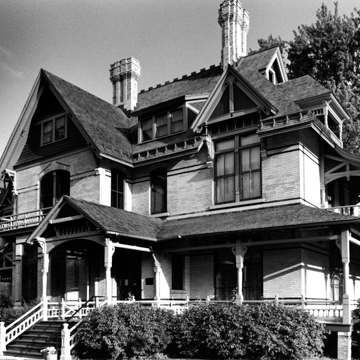In 1882, Henry Rogers hooked up his new house to a central hydroelectric power station, making it the first residence in America to be hydroelectrified. When Rogers, an executive for the local gas utility, heard about the steam-powered electric station Thomas Edison had built in New York City, he proposed to use the thirty-eight-foot drop of the Fox River to power an electric station here. With three local investors, Rogers formed the Appleton Edison Light Company, ordered two Edison K-type dynamos, and built a central generating station to power his Appleton Paper and Pulp Company and a nearby mill. Almost as an afterthought, he wired his home, then under construction. Not entirely trusting the new technology, he hedged his bets and installed pipes for gas service, too. As dusk fell on September 30, 1882, the hydroelectric generators hummed, and the new house glowed with incandescent light.
The asymmetrical, two-and-a-half-story Queen Anne house, designed by Waters of Oshkosh, finds expression in a variety of projections, roof lines, gables, porches, balconets, dormers, and surface treatments, including false half-timbering. At the east elevation, successively smaller porches step up from one story to the next, creating a tiered effect. Within, Flemish craftsman William van Stratam fashioned magnificent Eastlake woodwork with floral carvings. His nine fireplace mantels are particularly noteworthy. The parlor’s mantel is made of bird’s-eye maple, and birds make up the theme. Art glass chandeliers designed by Quezal Art Glass and Decoration Company hang in a number of the major rooms. Seven of the original brass toggle switches for electric lighting remain, but the original silk-insulated wiring has been replaced. The house was converted to a museum in 1988.















